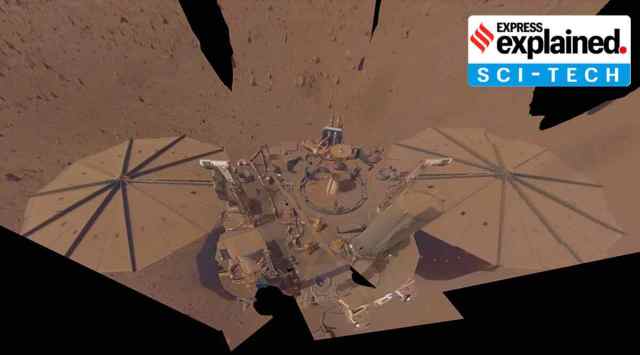Why NASA’s InSight Mars lander has tweeted it will be ‘signing off’ soon
“My power’s really low, so this may be the last image I can send. Don’t worry about me though: my time here has been both productive and serene,” NASA’s InSight Mars lander said in the tweet.
 NASA's InSight rover captured this 'selfie' on April 24, 2022. (Image credit: NASA/JPL-Caltech)
NASA's InSight rover captured this 'selfie' on April 24, 2022. (Image credit: NASA/JPL-Caltech) In a tweet on December 20, NASA’s InSight Mars lander account struck a sombre note and said the robot currently on Mars will be signing off soon, ending its nearly four-year-long journey to study the red planet’s early evolution.
“My power’s really low, so this may be the last image I can send. Don’t worry about me though: my time here has been both productive and serene,” it said in the tweet, which had what might be the last photo captured by it.
My power’s really low, so this may be the last image I can send. Don’t worry about me though: my time here has been both productive and serene. If I can keep talking to my mission team, I will – but I’ll be signing off here soon. Thanks for staying with me. pic.twitter.com/wkYKww15kQ
— NASA InSight (@NASAInSight) December 19, 2022
The account’s last few tweets were also in a similar vein, given that NASA was aware of the machine slowly powering down. Until a few months ago, InSight was active in its work, even detecting the strongest earthquakes recorded on Mars – dubbed ‘Marsquakes’ – in May this year.
What was the purpose of the InSight Lander?
The lander had two main functions, according to NASA. The first was to understand how rocky planets formed and evolved, and study the interior structure and geological processes of Mars through its various layers, such as the core, the mantle and the crust.
Second, InSight was to figure out just how tectonically active Mars is today, and how often meteorites impact it. This included measuring marsquakes, and more than 1,300 quakes have been detected.
“InSight has transformed our understanding of the interiors of rocky planets and set the stage for future missions,” said Lori Glaze, director of NASA’s Planetary Science Division. “We can apply what we’ve learned about Mars’ inner structure to Earth, the Moon, Venus, and even rocky planets in other solar systems.”
So why is InSight shutting down?
When InSight landed on Mars in 2018, its solar panels produced around 5,000 watt-hours on each Martian day, or sol. Each Martian day is 40 minutes longer than a day on earth. Now, they’re producing roughly 500 watt-hours per sol.
The reduced power is because the panels’ capacity to receive energy naturally reduces over time. There will be more dust in the air that would accumulate on the panels and therefore reduce the sunlight received – and the lander’s source of energy. While earlier some of the dust was removed, the mission would need a more powerful dust-cleaning event to reverse this, such as very strong winds.
Because of the reduced power, NASA announced in May this year that the team would soon put the lander’s robotic arm in its resting position (called the “retirement pose”).
Why was the robot sent to Mars?
According to NASA, there hasn’t been an adequate exploration of processes underneath the Martian surface, responsible for shaping above-ground formations.
Additionally, Mars also allows for a more practical study of the bigger questions about the solar system in the form of a “perfect laboratory”, it says. “In comparison to the other terrestrial planets, Mars is neither too big nor too small. This means that it preserves the record of its formation and can give us insight into how the terrestrial planets formed. It is the perfect laboratory from which to study the formation and evolution of rocky planets.”
- 01
- 02
- 03
- 04
- 05






































